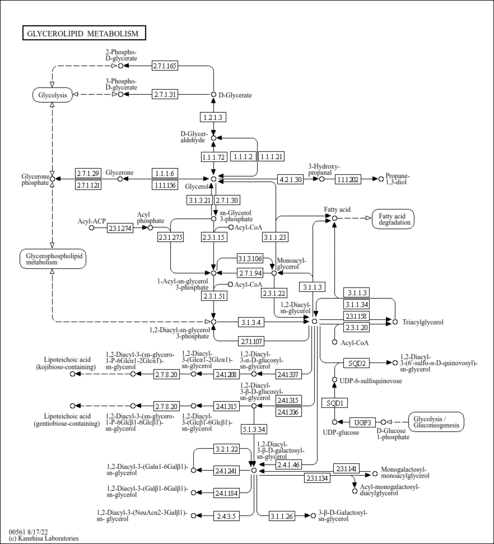| Identification |
|---|
| YMDB ID | YMDB01294 |
|---|
| Name | TG(16:0/18:1(9Z)/20:0) |
|---|
| Species | Saccharomyces cerevisiae |
|---|
| Strain | Brewer's yeast |
|---|
| Description | TG(16:0/18:1(9Z)/20:0) is a monoarachidic acid triglyceride. Triglycerides (TGs or TAGs) are also known as triacylglycerols or triacylglycerides, meaning that they are glycerides in which the glycerol is esterified with three fatty acid groups (i.e. fatty acid trimesters of glycerol). TGs may be divided into three general types with respect to their acyl substituents. They are simple or monoacid if they contain only one type of fatty acid, diacid if they contain two types of fatty acids and triacid if three different acyl groups. Chain lengths of the fatty acids in naturally occurring triglycerides can be of varying lengths and saturations but 16, 18 and 20 carbons are the most common. TG(16:0/18:1(9Z)/20:0), in particular, consists of one chain of palmitic acid at the C-1 position, one chain of oleic acid at the C-2 position and one chain of arachidic acid at the C-3 position. TGs are the main constituent of vegetable oil and animal fats. They contain more than twice the energy (9 kcal/g) of carbohydrates and proteins. (www.cyberlipid.org, www.wikipedia.org) |
|---|
| Structure | |
|---|
| Synonyms | - 1-palmitoyl-2-oleoyl-3-arachidonyl-glycerol
- TAG(16:0/18:1/20:0)
- TAG(16:0/18:1n9/20:0)
- TAG(16:0/18:1w9/20:0)
- TAG(54:1)
- TG(16:0/18:1/20:0)
- TG(16:0/18:1n9/20:0)
- TG(16:0/18:1w9/20:0)
- TG(54:1)
- Tracylglycerol(16:0/18:1/20:0)
- Tracylglycerol(16:0/18:1n9/20:0)
- Tracylglycerol(16:0/18:1w9/20:0)
- Tracylglycerol(54:1)
- Triacylglycerol
- triacylglycerols
- Triglycerid
- Triglyceride
- triglycerides
- Triglyzerid
- 1-arachidoyl-2-oleoyl-3-palmitoyl-glycerol
- TG(20:0/18:1/16:0)
- TG(20:0/18:1n9/16:0)
- TG(20:0/18:1w9/16:0)
- TG(54:1)
- Tag(20:0/18:1(9Z)/16:0)
- Tag(20:0/18:1/16:0)
- Tag(20:0/18:1n9/16:0)
- Tag(20:0/18:1w9/16:0)
- Tag(54:1)
- Triacylglycerol(20:0/18:1(9Z)/16:0)
- Triacylglycerol(20:0/18:1/16:0)
- Triacylglycerol(20:0/18:1n9/16:0)
- Triacylglycerol(20:0/18:1w9/16:0)
- Triacylglycerol(54:1)
- Triacylglycerol
- TG(20:0/18:1(9Z)/16:0)
|
|---|
| CAS number | Not Available |
|---|
| Weight | Average: 889.4638
Monoisotopic: 888.814591188 |
|---|
| InChI Key | YWKYRFUPKVVPAH-CZTCNMGMSA-N |
|---|
| InChI | InChI=1S/C57H108O6/c1-4-7-10-13-16-19-22-25-27-28-30-32-35-38-41-44-47-50-56(59)62-53-54(52-61-55(58)49-46-43-40-37-34-31-24-21-18-15-12-9-6-3)63-57(60)51-48-45-42-39-36-33-29-26-23-20-17-14-11-8-5-2/h26,29,54H,4-25,27-28,30-53H2,1-3H3/b29-26-/t54-/m1/s1 |
|---|
| IUPAC Name | (2R)-3-(hexadecanoyloxy)-2-[(9Z)-octadec-9-enoyloxy]propyl icosanoate |
|---|
| Traditional IUPAC Name | (2R)-3-(hexadecanoyloxy)-2-[(9Z)-octadec-9-enoyloxy]propyl icosanoate |
|---|
| Chemical Formula | C57H108O6 |
|---|
| SMILES | [H][C@@](COC(=O)CCCCCCCCCCCCCCC)(COC(=O)CCCCCCCCCCCCCCCCCCC)OC(=O)CCCCCCC\C=C/CCCCCCCC |
|---|
| Chemical Taxonomy |
|---|
| Description | belongs to the class of organic compounds known as triacylglycerols. These are glycerides consisting of three fatty acid chains covalently bonded to a glycerol molecule through ester linkages. |
|---|
| Kingdom | Organic compounds |
|---|
| Super Class | Lipids and lipid-like molecules |
|---|
| Class | Glycerolipids |
|---|
| Sub Class | Triradylcglycerols |
|---|
| Direct Parent | Triacylglycerols |
|---|
| Alternative Parents | |
|---|
| Substituents | - Triacyl-sn-glycerol
- Tricarboxylic acid or derivatives
- Fatty acid ester
- Fatty acyl
- Carboxylic acid ester
- Carboxylic acid derivative
- Organic oxygen compound
- Organic oxide
- Hydrocarbon derivative
- Organooxygen compound
- Carbonyl group
- Aliphatic acyclic compound
|
|---|
| Molecular Framework | Aliphatic acyclic compounds |
|---|
| External Descriptors | |
|---|
| Physical Properties |
|---|
| State | Solid |
|---|
| Charge | 0 |
|---|
| Melting point | Not Available |
|---|
| Experimental Properties | | Property | Value | Reference |
|---|
| Water Solubility | Not Available | PhysProp | | LogP | Not Available | PhysProp |
|
|---|
| Predicted Properties | |
|---|
| Biological Properties |
|---|
| Cellular Locations | Not Available |
|---|
| Organoleptic Properties | Not Available |
|---|
| SMPDB Pathways | Not Available |
|---|
| KEGG Pathways | |
|---|
| SMPDB Reactions | Not Available |
|---|
| KEGG Reactions | Not Available |
|---|
| Concentrations |
|---|
| Intracellular Concentrations | | Intracellular Concentration | Substrate | Growth Conditions | Strain | Citation |
|---|
| 1250 ± 75 umol/L | SD media with 2% raffinose | 24 oC | BY4741 | PMID: 19174513 | | Conversion Details Here |
|
|---|
| Extracellular Concentrations | Not Available |
|---|
| Spectra |
|---|
| Spectra | | Spectrum Type | Description | Splash Key | View |
|---|
| Predicted LC-MS/MS | Predicted LC-MS/MS Spectrum - 10V, Positive | Not Available | JSpectraViewer | | Predicted LC-MS/MS | Predicted LC-MS/MS Spectrum - 20V, Positive | Not Available | JSpectraViewer | | Predicted LC-MS/MS | Predicted LC-MS/MS Spectrum - 40V, Positive | Not Available | JSpectraViewer | | Predicted LC-MS/MS | Predicted LC-MS/MS Spectrum - 10V, Negative | Not Available | JSpectraViewer | | Predicted LC-MS/MS | Predicted LC-MS/MS Spectrum - 20V, Negative | Not Available | JSpectraViewer | | Predicted LC-MS/MS | Predicted LC-MS/MS Spectrum - 40V, Negative | Not Available | JSpectraViewer |
|
|---|
| References |
|---|
| References: | - Ejsing, C. S., Sampaio, J. L., Surendranath, V., Duchoslav, E., Ekroos, K., Klemm, R. W., Simons, K., Shevchenko, A. (2009). "Global analysis of the yeast lipidome by quantitative shotgun mass spectrometry." Proc Natl Acad Sci U S A 106:2136-2141.19174513
|
|---|
| Synthesis Reference: | Not Available |
|---|
| External Links: | |
|---|

